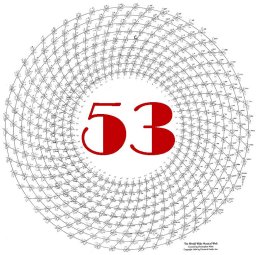Next Page: 15/4 – Whole Tone Scales etc.
Tone Clusters
A great way to create the effect of atonality is through Schönberg ‘s dodecaphonic technique of avoidance. If a chord employs matchstick harmonies in a triangular shape, a tone cluster will avoid being limited to the triangular “matchstick” relationships. When you plot these tone clusters out on a lattice, you’ll sometimes find good-sized gaps among each pair of notes. Other times, you’ll find the notes of clusters traveling vertically or horizontally three or more times. Sounding tones together that far apart on the lattice strains the ear’s ability to understand the connection. Below is a sample list of some really cool sounding tone clusters. Not all of them are dense, but the harmonic relationships among the notes are certainly more distant and obscure, and never limited to the right-leaning triangles of our traditional chords. The clusters played below are not intended to be any kind of “progression.” Listen to each cluster separately to hear the soundscape it creates. The main commonality is that each row of clusters goes in a different direction: (NE = Northeast from C, SE = Southeast from C, etc.). If you want to create a progression of clusters, try moving one or two pitches in the cluster to notes that are harmonically close by. For example, look at the first cluster, a rather simple one where the C – D ninth leaves out the perfect fifth G in the middle. The ga-spine is directly above the C – D spine, and also creates two notes a ninth (or second) apart from one another. So maybe you can move one of the notes into that gap; for example, the F# can move to a G, creating a C – G – D spine with a ga-E above the C. That creates something even easier to hear. Or, you can move the F# to an F, expanding the width of the lower spine to F – C – D. That creates a more esoteric, distant feel as the harmonic relationships get further away.
When the notes are packed closer together, of course they sound more dense. The tones are easier for the ear to pick apart when they are spread over three octaves or more. Also, when you travel into the Northeast (NE) or NW (Northwest) quadrants, you tend to hear a more “Major” affect to the clusters. The Southeast and Southwest quadrants relative to C elicit a minor feel, just as you hear in major and minor chords whose notes are north or south relative to C. Listen carefully: can you hear the difference between these complex but harmonically grounded tone clusters and the kinds of acoustical dissonances you can create at a piano? You can see the parts of the lattice being used to create these clusters above each one. I use C as a “center point” rather arbitrarily, by making most of the tone clusters have the note C in either the bass or the soprano.
Figure 15-2 Tone clusters with sound
If you would like to learn more about the ancient tunings worldwide and contemporary musical ideas for 53-equal tuning, you can buy the entire book, The Grand Unified Theory of Music, in pdf form for $25 with hundreds of embedded musical examples of scales and chords from all over the world.
A free introduction to what The Grand Unified Theory of Music offers is on this website and includes both text and a few musical examples from each webpage. If you would like to learn more about this chapter and the full contents of this entire e-book, you can buy The Grand Unified Theory of Music for $25, with hundreds of embedded musical examples of scales and chords from all over the world — and ideas for how to set up your computer system —
HERE.
You’ll get a personalized password you can use to see the entire e-book. Inside the full book, you will also get a link to the complete pdf file of this e-book, which you can read on your Kindle or similar device. The links to the hundreds of mp3 sound files – the same ones you can hear on the website — will also be included. This is “Version 1.0” of The Grand Unified Theory of Music. Because it is an e-book, additions, corrections and improvements in the sound may be added at any time. The Grand Unified Theory of Music is Copyright © 2018 by Christopher Mohr. All rights reserved.
One person per password. Sharing this password with others is a violation of copyright. Do not allow others to use your password or link to the pdf file!

